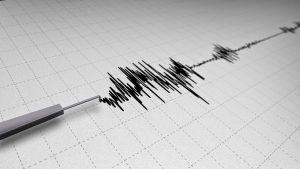
Careful analysis of data collected after the 3 September 2017 North Korean declared nuclear test explosion has allowed seismologists to distinguish the separate seismic signatures of the explosion, a collapse of the explosion cavity and even several small earthquakes that occurred after the collapse.
The data, compared with those collected from 20th-century Nevada nuclear test sites, can help refine seismologists’ methods of identifying nuclear test explosions around the world, write William R. Walter and his colleagues at Lawrence Livermore National Laboratory. Their paper is published as part of a special focus section on the September 2017 North Korean explosion and its aftermath in the journal Seismological Research Letters.
The September 2017 body-wave magnitude 6.1 underground test by the Democratic People’s Republic of Korea (DPRK) is the largest such test in more than 20 years, and is the sixth declared nuclear test by the DPRK since 2006. The September explosion is an order of magnitude larger than the next largest test by the country, which occurred in September 2016.
The researchers used a method that compares the ratio between regional P- and S-wave amplitudes to distinguish the seismic signature of an explosion compared to an earthquake, at distances about 200 to 1500 kilometers away from the seismic wave source. (P-waves compress rock in the same direction as the seismic wave’s movement, while S-waves move rock perpendicular to the direction of the wave.) “In the P/S ratio discriminant we use to identify explosions, it is the lack of S-waves at high frequency that is distinctive of the explosions,” Walter explained.
Walter and colleagues showed that the ratio could separate the six North Korean declared nuclear tests from natural earthquakes in the region, and that the same method could be used to successfully distinguish between historic Nevada Test Site nuclear explosions and earthquakes in the western United States.
However, there was another unusual seismic event, occurring about eight and half minutes after the explosion, which also drew the attention of the seismologists. Models of seismic waveforms of the event led the scientists to conclude that the event may have been the ground collapsing around an underground cavity left by the explosion.
Although collapses similar to this were sometimes seen after Nevada Test Site explosions, “this is the first time, to my knowledge, that we have remotely observed seismic waves from a collapse with modern instrumentation at a foreign test site,” said Walter. “It is important to be able to determine this collapse was not another nuclear test.”
Several features of the post-explosion event’s waveforms mark it as a collapse rather than an explosion, the researchers say, including the relative lack of high frequency energy compared to explosion waveforms.
“Identifying the event as a collapse is another indicator the 3 September 2017 event was a nuclear test that generated a large vaporization cavity that collapsed eight and half minutes later,” said Walter. “But we want to continue to develop methods to identify collapses to distinguish them from both explosions and earthquakes.”
Researchers studying the September 2017 nuclear test data also noted two smaller seismic events occurring after the explosion, of magnitudes 2.6 and 3.4, that appear from the P- to S-wave ratios to be small earthquakes located four to eight kilometers north of the explosion site.
“We had not remotely observed any aftershocks from the prior DPRK declared nuclear tests, so the earthquakes following the explosion got people’s attention,” Walter said. “Again, we wanted to determine they were not additional smaller nuclear tests. Alternatively, we wanted to determine they were not associated with the collapse event.” Upon careful re-analysis of the continuous data the researchers found a number of additional small earthquakes, including some that occurred before the 3 September 2017 declared nuclear test.
Given the timing these earthquakes do not appear to be true “aftershocks” of the nuclear test, Walter and colleagues concluded, though they may be related and possibly induced by the explosion. “The fact that apparent tectonic earthquakes are occurring near the DPRK test site reveals information about the state of [seismic] stress in the region, which may help us better understand the explosion seismic signatures,” said Walter.
Reference:
Andrea Chiang et al, Moment Tensor Source‐Type Analysis for the Democratic People’s Republic of Korea–Declared Nuclear Explosions (2006–2017) and 3 September 2017 Collapse Event, Seismological Research Letters (2018). DOI: 10.1785/0220180130
Note: The above post is reprinted from materials provided by Seismological Society of America.










